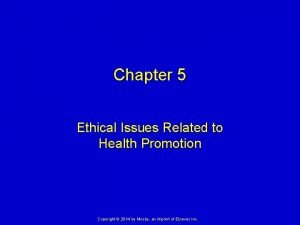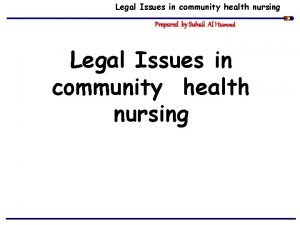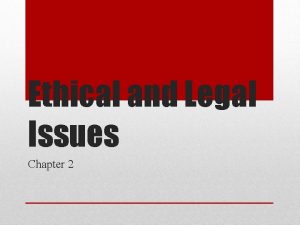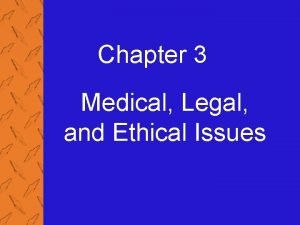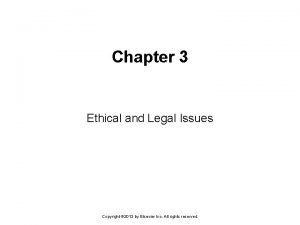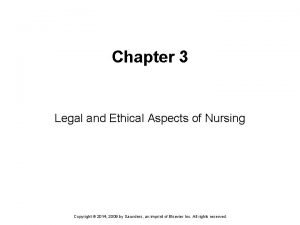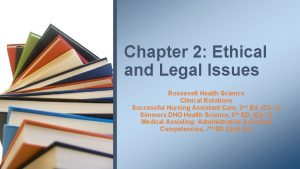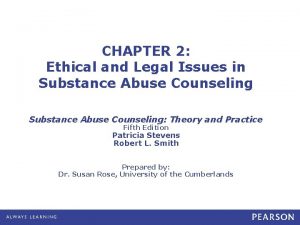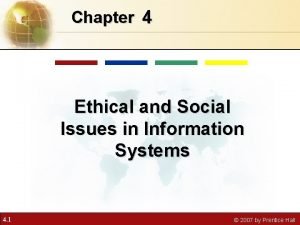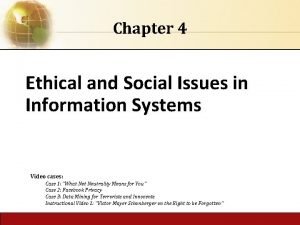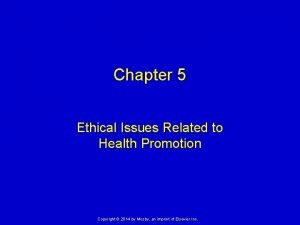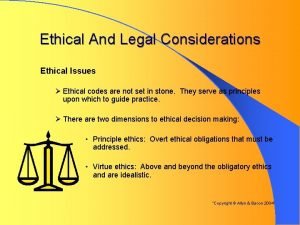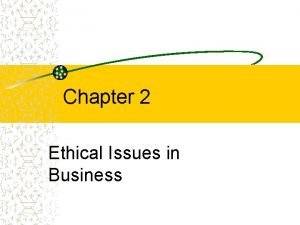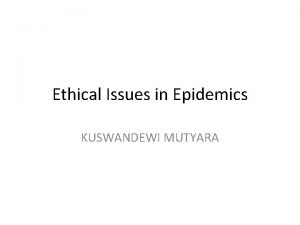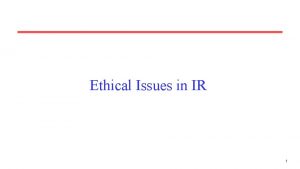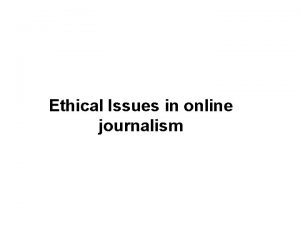Chapter 5 Ethical Issues Related to Health Promotion




























- Slides: 28

Chapter 5 Ethical Issues Related to Health Promotion Copyright © 2014 by Mosby, an imprint of Elsevier Inc.

Health Promotion as a Moral Endeavor When nurses provide service to society through health-promotion interventions, their care for individuals can be seen as a moral endeavor. In order to set higher standard of health for all people, there needs to be a change in our approach to understanding health and the development of health-promotion ethics. Copyright © 2014 by Mosby, an imprint of Elsevier Inc. 2

Health Care Ethics Applied ethics—uses moral philosophy to formulate theories guiding actions in practice that most consistently result in good action or avoid harmful actions Moral philosophy—concerned with what is right or wrong, good or bad, in human action toward other humans, animals, and the environment Copyright © 2014 by Mosby, an imprint of Elsevier Inc. 3

Health Care Ethics (Cont. ) Value theories—result from philosophical inquiry about good action Ø Descriptive theories—concerned what humans seem to value Ø Normative theories—proposes what people ought to value given some presupposed philosophy of human nature/purpose, or in order to achieve predetermined goals Metaethics—evaluates theories/perspectives for congruence and usefulness in decision making across environments Copyright © 2014 by Mosby, an imprint of Elsevier Inc. 4

Health Professionals’ Moral Responsibilities Health professionals have moral responsibilities toward individuals and society with regard to facilitating health and wellbeing, or the relief of suffering Professional responsibilities/obligations are laid out in the profession’s code of ethics, which serves as a standard American Nurses Association code of ethics Ø International Council of Nurses code of ethics Ø Copyright © 2014 by Mosby, an imprint of Elsevier Inc. 5

Applying Ethics to Practice Ethical theories can be useful in highlighting salient aspects of complex problems, serving as potential tools in problem-solving. However, all moral theories have flaws; it is not prudent to adopt one theory to guide actions in every situation. Combining principles derived from a variety of ethical theories (a philosophical framework for action) with contextual considerations increases the likelihood of effective/beneficial actions. Copyright © 2014 by Mosby, an imprint of Elsevier Inc. 6

Feminist Ethics Characteristics Recognizes that human beings are inseparable from their relationships with others Ø Focuses on care and responsibility in relationships rather than applying abstract principles (Davis et al. , 1997) Ø Concerned with the development of character and attitudes that result in caring actions reflective of a person who is related to, rather than detached from, context Ø Concern for rights of individuals and for equality that is not limited to the oppression of women Ø Copyright © 2014 by Mosby, an imprint of Elsevier Inc. 7

Feminine Ethic of Care Based on the work of Carol Gilligan (1982) Recognizes a responsibility to attend to the individual in all of his or her complexities The needs and interests of the individual are uncovered as a result of focused attention Ø Interrelationships and contexts are important Ø Care involves alleviation of vulnerability, promotion of growth and health, facilitation of comfort, dignity, and a good or peaceful death Ø Copyright © 2014 by Mosby, an imprint of Elsevier Inc. 8

Professional Responsibilities Accountability to individuals and society Codes of ethics outline professional promises of service to society Ø Members of the profession are held accountable for their practice and are morally accountable for practicing according to the profession’s code of ethics Ø Trust Ø Patients are in the position of having to trust that the health care professional will keep their best interests as the primary goal and will strive to meet their needs Copyright © 2014 by Mosby, an imprint of Elsevier Inc. 9

Professional Responsibilities (Cont. ) Nursing’s Social Policy Statement (ANA, 2003) Nursing is the protection, promotion, and optimization of health and abilities, prevention of illness and injury, alleviation of suffering through diagnosis and treatment, and advocacy in the care of individuals, families, communities, and populations. Ø In addition to responsibilities for ensuring good care, nurses also are responsible for recognizing and addressing barriers to service. Ø Copyright © 2014 by Mosby, an imprint of Elsevier Inc. 10

Professional Responsibilities (Cont. ) Advocacy Defined as aggressive action taken on behalf of an individual or group to protect or secure that individual’s/group’s rights Ø Requires attention to individuals and to broader social concerns Ø Advocacy in health care settings can be complicated. • Health professionals serve individuals with competing Ø needs, and boundaries of the professional’s responsibilities are often not well defined. Copyright © 2014 by Mosby, an imprint of Elsevier Inc. 11

Ethical Problem Solving Issues—ethical problems in which a choice must be made Dilemmas—situations in which a choice must be made between two or more equally undesirable options True dilemmas are rare, but neglected issues can become dilemmas Copyright © 2014 by Mosby, an imprint of Elsevier Inc. 12

Preventative Ethics Aims to interrupt potential ethical problems before they develop Health promoter envisions potential problems and institutes action to halt their development Copyright © 2014 by Mosby, an imprint of Elsevier Inc. 13

Ethical Principles in Health Promotion Autonomy To do good Ø Can conflict with autonomy Freedom of action Ø Self-determination Ø Ø Veracity Ø Devotion to the truth Nonmaleficence Ø Beneficence Justice Ø Fairness Not harming others Copyright © 2014 by Mosby, an imprint of Elsevier Inc. 14

Autonomy as Civil Liberty Autonomy as a civil liberty, or an individual’s freedom of action, is considered a prerequisite of human flourishing in most Western contexts but is limited by the duty of protecting the health and safety of society Ø Some potential threats that pose a danger to society’s health and safety include bioterrorism, the spread of HIV/AIDS, drug-resistant tuberculosis, and advances in genetic knowledge. Copyright © 2014 by Mosby, an imprint of Elsevier Inc. 15

Autonomy as Self-Determination Self-determination Based on the human capacity for reason and thus for self-governance Ø Individuals should be permitted to make their own decisions, even when these decisions seem to others to be ill-informed Ø Exceptions • Situations in which there is a high risk of serious Ø injury/death, and when it cannot be determined whether the person’s judgment is impaired (we suspect the individual is not able to reason adequately) Copyright © 2014 by Mosby, an imprint of Elsevier Inc. 16

Informed Consent Informed consent to research, treatments, or health-promotion endeavors involves ensuring that a person has all of the information necessary to come to a decision that facilitates autonomous action Ø Proxy decision making • Certain populations considered less than fully autonomous (at least in some situations) for a variety of reasons (e. g. , children, people with Alzheimer’s disease) • Must take into account what is known about the person and follow a path of action most likely to respect the individual’s previous goals and values when these are knowable Copyright © 2014 by Mosby, an imprint of Elsevier Inc. 17

Confidentiality Confidentiality—people have the right to decide who shall have access to information about them, thus limiting the negative use of personal information by others Ø Health care professionals must strive to keep patients’ personal information confidential • Disclose only as much information as necessary to permit optimal care and only information that is pertinent to the situation • Overridden only in situations in which extreme harm to the patient or others is imminent Copyright © 2014 by Mosby, an imprint of Elsevier Inc. 18

The Privacy Rule Developed as a result of the Health Insurance Portability and Accountability Act (HIPAA) Attempts to ensure that individuals’ health information is properly protected, while allowing flow of information needed to provide high-quality care and protect public health Ensures that patients are given a copy of the privacy practices at a given institution Copyright © 2014 by Mosby, an imprint of Elsevier Inc. 19

Confidentiality Issues With Adolescents Confidentiality issues in the task of facilitating adolescents’ emerging autonomy and confidentiality needs Health care professionals potentially caught in tension between a teenager wanting to assert independence and parental figure(s) who feel they have a right to information Ø Handle situation in a manner that preserves trust and support; if necessary, solicit appropriate advice from a peer/resource Ø Copyright © 2014 by Mosby, an imprint of Elsevier Inc. 20

Veracity Devotion to the truth Involves trust, the basis of health care provider -patient relationships Compromised when a professional withholds information a patient has a right to know or gives misleading/incomprehensible information Knowledge of the patient’s beliefs, values, and lifestyle preferences are essential to supplying adequate information Ø How much and which types of information will best serve the patient’s needs? Copyright © 2014 by Mosby, an imprint of Elsevier Inc. 21

Nonmaleficence Enjoins people not to harm other people Harm may be intentional or unintentional (caused by indifferent/incompetent decision making) Professionals involved in health promotion are responsible foreseeing predictable adverse consequences and taking these into consideration Copyright © 2014 by Mosby, an imprint of Elsevier Inc. 22

Beneficence Quality or state of doing/producing good Maximizing the benefits of actions while minimizing harms May involve rules that are designed to protect people against the negative effects of their own actions Paternalism—interference of a state or individual with another person, justified by the claim that the person will be better off/protected from harm Ø Interferes with autonomy; not a decision to be taken lightly Ø Copyright © 2014 by Mosby, an imprint of Elsevier Inc. 23

Justice Social justice—systems existing within a society that determine the distribution of goods such as health, education, food, shelter In democratic societies, justice theoretically includes equitable distribution of the benefits and burdens of societal life (equal rights) Copyright © 2014 by Mosby, an imprint of Elsevier Inc. 24

Two Views of Justice Two socially-oriented views Justice based on deserving—those more worthy of merit/who contribute more deserve better social benefits Ø Justice based on fairness—benefits are equalized across society regardless of merit Ø Provision of health care tends to focus on justice viewed as fairness and as favoring equality Copyright © 2014 by Mosby, an imprint of Elsevier Inc. 25

Strategies for Ethical Decision Making Identify the problem or issue Identify the level of the problem or issue Ø Individual, group, social Identify the ethical principle(s) involved Identify who/what created the problem or issue Determine prevalent values Copyright © 2014 by Mosby, an imprint of Elsevier Inc. 26

Strategies for Ethical Decision Making (Cont. ) Identify information gaps Formulate possible course of action and probable consequences Initiate selected course of action and evaluate the outcome Engage in self- and peer-reflection Copyright © 2014 by Mosby, an imprint of Elsevier Inc. 27

Ethics of Health Promotion: Cases Case 1: Addressing health care system problems (Refer to case on textbook pp. 122123) Case 2: Balancing one patient’s privacy with another patient’s health (Refer to case on textbook p. 123) Case 3: Respecting patient autonomy and best interest (Refer to case on textbook p. 123) Copyright © 2014 by Mosby, an imprint of Elsevier Inc. 28
 Five ethics in health promotion
Five ethics in health promotion Health related fitness and skill related fitness
Health related fitness and skill related fitness Legal issues in community health nursing
Legal issues in community health nursing Chapter 2 ethical and legal issues
Chapter 2 ethical and legal issues Medical legal and ethical issues chapter 3
Medical legal and ethical issues chapter 3 Legal and ethical issues chapter 3
Legal and ethical issues chapter 3 Legal and ethical issues chapter 5
Legal and ethical issues chapter 5 Emt chapter 3 medical legal and ethical issues
Emt chapter 3 medical legal and ethical issues Chapter 6 legal and ethical issues
Chapter 6 legal and ethical issues Chapter 5 legal and ethical responsibilities
Chapter 5 legal and ethical responsibilities Chapter 4 ethical and social issues in information systems
Chapter 4 ethical and social issues in information systems Ethical issues in qualitative research chapter 4
Ethical issues in qualitative research chapter 4 Chapter 2 legal and ethical aspects of nursing
Chapter 2 legal and ethical aspects of nursing Ethical and legal issues chapter 2
Ethical and legal issues chapter 2 Chapter 2 ethical and legal issues
Chapter 2 ethical and legal issues Ch 5 legal and ethical responsibilities
Ch 5 legal and ethical responsibilities Legal and ethical issues chapter 5
Legal and ethical issues chapter 5 Chapter 2 ethical and legal issues
Chapter 2 ethical and legal issues Chapter 4 ethical issues
Chapter 4 ethical issues Chapter 4 ethical issues
Chapter 4 ethical issues 4 components of an information system
4 components of an information system Chapter 6 legal and ethical issues
Chapter 6 legal and ethical issues Chapter 6 legal and ethical issues
Chapter 6 legal and ethical issues Medical legal and ethical issues chapter 3
Medical legal and ethical issues chapter 3 10 difference between health education and health promotion
10 difference between health education and health promotion Health maintenance and promotion
Health maintenance and promotion Pcb 3703c ucf
Pcb 3703c ucf National program for child health
National program for child health The integration of eye, hand, and foot movements
The integration of eye, hand, and foot movements
